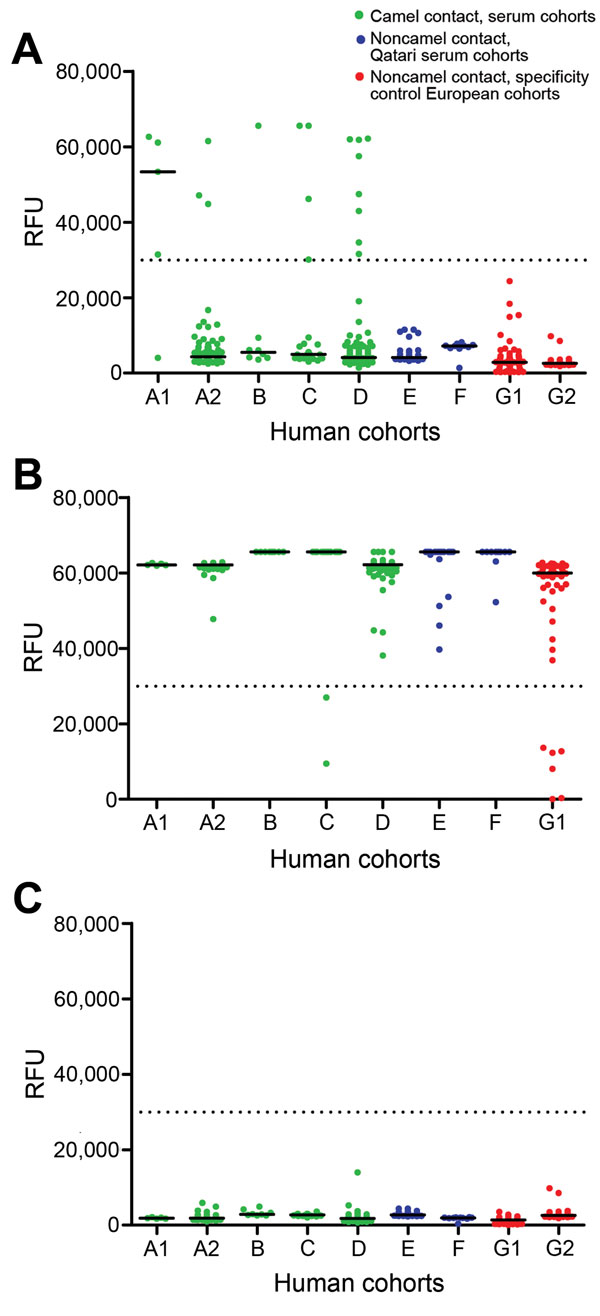Occupational Exposure to Dromedaries and Risk for MERS-CoV Infection, Qatar, 2013–2014
Chantal B.E.M. Reusken
1
, Elmoubasher A.B.A. Farag
1, Bart L. Haagmans
1, Khaled A. Mohran
1, Gert-Jan Godeke, Stalin Raj, Farhoud Alhajri, Salih A. Al-Marri, Hamad Al-Romaihi, Mohamed Al-Thani, Berend-Jan Bosch, Annemiek A. van der Eijk, Ahmed M. El-Sayed, Adel K. Ibrahim, N. Al-Molawi, Marcel A. Müller, Syed K. Pasha, Sung Sup Park, Mohd M. AlHajri, and Marion P.G. Koopmans
Author affiliations: Erasmus Medical Center, Rotterdam, the Netherlands (C.B.E.M. Reusken, B.L. Haagmans, V.S. Raj, A.A. van der Eijk, M.P.G. Koopmans); Supreme Council of Health, Doha, Qatar (E.A.B.A Farag, S.A. Al-Marri, H.E. Al-Romaihi, M. Al-Thani, A.M. El-Sayed, M.M. AlHajri); Agricultural Research Center, Cairo, Egypt (K.A. Mohran); Ministry of Environment, Doha (K.A. Mohran, F. Alhajri); National Institute for Public Health and the Environment, Bilthoven, the Netherlands (G.-J. Godeke, M.P.G. Koopmans); Utrecht University, Utrecht, the Netherlands (B.-J. Bosch); Leawaina Camel Hospital, Dukhan, Qatar (A.K. Ibrahim, S.K. Pasha); Hamad Medical Centre, Doha (N. Al-Molawi); University of Bonn Medical Center, Bonn, Germany (M.M. Müller, C. Drosten)
Main Article
Figure

Figure. Reactivity of human serum samples, from persons with and without dromedary contact, with S1 antigens of various coronaviruses (CoVs), Qatar, 2013–2014. A) Middle East respiratory syndrome CoV S1; B) human CoV OC43 S1; C) severe acute respiratory syndrome CoV S1. Relative fluorescent units (RFU) are shown at a serum dilution of 1:20. Black lines indicate median; dotted black lines at 30,000 RFU depict cutoff for analysis. Human cohorts: A1, camel slaughterers; A2, sheep slaughterers who had contact with dromedaries and camel slaughterers; B, workers at the central animal market; C, barn workers at the international camel racing track; D, workers on camel farms; E, construction workers; F, sheep farmers; G1, persons recently infected with a common human CoV (serum samples from the Netherlands and Germany); G2, persons with suspected Bordetella pertussis infection (serum samples from the Netherlands).
Main Article
Page created: July 15, 2015
Page updated: July 15, 2015
Page reviewed: July 15, 2015
The conclusions, findings, and opinions expressed by authors contributing to this journal do not necessarily reflect the official position of the U.S. Department of Health and Human Services, the Public Health Service, the Centers for Disease Control and Prevention, or the authors' affiliated institutions. Use of trade names is for identification only and does not imply endorsement by any of the groups named above.
